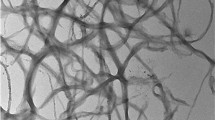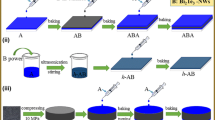Abstract
A simple method to fabricate three-dimensionally (3-D) aligned thermoelectric nanowires attached polymer particle was demonstrated by combination of solution casting of thermoelectric nanostructures (e.g., tellurium nanowires (Te NWs)) on the surface of thermoplastic polymer (e.g., poly(methyl methacrylate (PMMA)) microbeads followed by hot compaction of thermoplastic matrix. The percolation threshold of composite with 3-D assembled Te NWs (i.e., 3.45 vol%) significantly was lower than that of a randomly dispersed Te NWs (i.e., 5.26 vol%), which resulted in an order of magnitude greater thermoelectric figure of merit (ZT of 2.8 × 10−3) compared to randomly dispersed Te NWs in PMMA matrix (ZT of 6.4 × 10−4) at room temperature by enhancing the electrical conductivity without increasing thermal conductivity.





Similar content being viewed by others
References
Majumdar A (2004) Thermoelectricity in semiconductor nanostructures. Science 303:777–778
Zhang B, Sun J, Katz HE, Fang F, Opila RL (2010) Promising thermoelectric properties of commercial PEDOT: PSS materials and their Bi2Te3 powder composites. ACS Appl Mater Interfaces 2:3170–3178
Song H, Liu C, Zhu H, Kong F, Lu B, Xu J, Wang J, Zhao F (2013) Improved thermoelectric performance of free-standing PEDOT: PSS/Bi2Te3 films with low thermal conductivity. J Electron Mater 42:1268–1274
Wang Q, Yao Q, Chang J, Chen L (2012) Enhanced thermoelectric properties of CNT/PANI composite nanofibers by highly orienting the arrangement of polymer chains. J Mater Chem 22:17612–17618
Chatterjee K, Mitra M, Kargupta K, Ganguly S, Banerjee D (2013) Synthesis, characterization and enhanced thermoelectric performance of structurally ordered cable-like novel polyaniline-bismuth telluride nanocomposite. Nanotechnology 24:215703 (10 pp)
Bubnova O, Crispin X (2012) Towards polymer-based organic thermoelectric generators. Energy Environ Sci 5:9345–9362
Pang H, Piao Y-Y, Tan Y-Q, Jiang G-Y, Wang J-H, Li Z-M (2013) Thermoelectric behavior of segregated conductive polymer composites with hybrid fillers of carbon nanotube and bismuth telluride. Mater Lett 107:150–153
Han S, Chung DDL (2013) Carbon fiber polymer-matrix structural composites exhibiting greatly enhanced through-thickness thermoelectric figure of merit. Compos A 48:162–170
Yang Y, Lin Z-H, Hou T, Zhang F, Wang ZL (2012) Nanowire-composite based flexible thermoelectric nanogenerators and self-powered temperature sensors. Nano Res 5:888–895
Pang H, Xu L, Yan D-X, Li Z-M (2014) Conductive polymer composites with segregated structures. Prog Polym Sci 39:1908–1933
Lee TI, Lee S, Lee E, Sohn S, Lee Y, Lee S, Moon G, Kim D, Kim YS, Myung JM, Wang ZL (2013) High-power density piezoelectric energy harvesting using radially strained ultrathin trigonal tellurium nanowire assembly. Adv Mater 25:2920–2925
Liu J-W, Zhu J-H, Zhang C-L, Liang H-W, Yu S-H (2010) Mesostructured assemblies of ultrathin superlong tellurium nanowires and their photoconductivity. J Am Chem Soc 132:6945–6952
Das VD, Jayaprakash N, Soundararajan N (1981) Thermoelectric power of tellurium films and its thickness and temperature dependence. J Mater Sci 16:3331–3334
Xi Y, Yamanaka A, Bin Y, Matsuo M (2007) Electrical properties of segregated ultrahigh molecular weight polyethylene/multiwalled carbon nanotube composite. J Appl Polym Sci 105:2868–2876
Shrivastava NK, Khatua BB (2011) Development of electrical conductivity with minimum possible percolation threshold in multi-wall carbon nanotube/polystyrene composites. Carbon 49:4571–4579
See KC, Feser JP, Chen CE, Majumdar A, Urban JJ, Segalman RA (2010) Water-processable polymer-nanocrystal hybrids for thermoelectrics. Nano Lett 10:4664–4667
Yu C, Kim YS, Kim D, Grunlan JC (2008) Thermoelectric behavior of segregated-network polymer nanocomposites. Nano Lett 8:4428–4432
Kim YS, Kim D, Martin KJ, Yu C, Grunlan JC (2010) Influence of stabilizer concentration on transport behavior and thermopower of CNT-filled latex-based composites. Macromol Mater Eng 295:431–436
Antar Z, Feller JF, Noël H, Glouannec P, Elleuch K (2012) Thermoelectric behavior of melt processed carbon nanotube/graphite/poly(lactic acid) conductive biopolymer nanocomposites (CPC). Mater Lett 67:210–214
Stauffer D (1984) Introduction to the percolation theory. Tayler and Francis, London
Lebovka N, Lisunova M, Mamunya YP, Vygornitskii N (2006) Scaling in percolation behaviour in conductive-insulating composites with particles of different size. J Phys D Appl Phys 39:2264–2271
Linares A, Canalda JC, Cagiao ME, Ezquerra TA (2011) Conducting nanocomposites based on polyamide 6,6 and carbon nanofibers prepared by cryogenic grinding. Compos Sci Technol 71:1348–1352
Regev O, Elkati PNB, Loos J, Koning CE (2004) Preparation of conductive nanotube-polymer composites using latex technology. Adv Mater 16:248–251
Chen J, Shi Y-Y, Yang J-H, Zhang N, Huang T, Chen C, Wang Y, Zhou Z-W (2012) A simple strategy to achieve very low percolation threshold via the selective distribution of carbon nanotubes at the interface of polymer blends. J Mater Chem 22:22398–22404
Acknowledgements
This work was supported by a grant from the Fundamental R&D Program for Core Technology of Materials (10050890, Chalcogenide nanostructure-based room-temperature (25 °C) H2 & H2S gas sensors with low power consumption) and supported by Nano Material Technology Development Program through the National Research Foundation of Korea (NRF) funded by the Ministry of Science, ICT and Future Planning (No. 2016M3A7B4900044).
Author information
Authors and Affiliations
Corresponding authors
Electronic supplementary material
Below is the link to the electronic supplementary material.
Rights and permissions
About this article
Cite this article
Kim, S., Lee, YI., Ryu, S.H. et al. Synthesis and thermoelectric characterization of bulk-type tellurium nanowire/polymer nanocomposites. J Mater Sci 52, 12724–12733 (2017). https://doi.org/10.1007/s10853-017-1384-z
Received:
Accepted:
Published:
Issue Date:
DOI: https://doi.org/10.1007/s10853-017-1384-z




